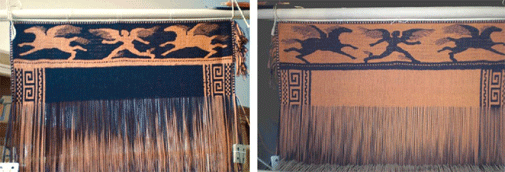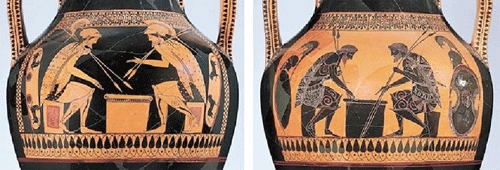Periphron Penelopeia - Textile Technology and the Tacit Dimension of Thought in Ancient Greece
Project by Ellen Harlizius-Klück
The aim of the project is to investigate the relevance of textile structure and technology for styles of thought and ordering concepts of Greek antiquity.
Within TEMA it covers the task of integrating textile research into the understanding of culture in ancient Greece and focuses on the distribution of textile technology related patterns into science and philosophy. Mostly attributed as metaphors, textile technology provides the invisible craft to gain knowledge on cosmic and social order.
In weaving, patterns and pictures may be seen as figured atoms that provide a kind of tacit reasoning on a world view that makes abstract processes and structures visible. Therefore, this project intends to analyze textile processes and structures in order to reveal figures, ideas and concepts of order that prefigured scientific thought in Greek antiquity, one that has a marked tendency towards dyadic structures, pairs, doubles and turns possibly originated in weaving techniques (see figures 1 and 2 below of reconstructed weaving and bilingual pottery (pottery combining black and red‐figured technique on one object).

Figure 1: Double weave with double tablet‐border made by Ellen Harlizius‐Klück.
Left: back‐side, right: front‐side

Figure 2: Achilles and Aias playing a game with pebbles (psephoi), bilingual amphora of Andokides, ca. 525 BC
The terms periphron and tacit used in the project title both denote a kind of reasoning that is not addressed in a scientific or objective sense.
Penelope is called periphron in some 50 instances of the Odyssey. The term is mostly translated as “circumspect” and means that her awareness extends in all directions. Odysseus is named Polytropos, a man of many turns. I take these kinds of thoughtfulness as tacit ones that means they remain unspoken and sometimes unspeakable.
Michael Polanyi explains the tacit inference of such knowledge through a comparison with the way we recognize a person’s face. Crucial for the tacit dimension concept is the recognition of physiognomies and patterns, of “Gestalt”. It is this structure of organizing elements to wholes that makes the process similar to the weaving process, where “Gestalten” has to be produced out of elements (threads) that have no Gestalt‐features by themselves. For Polanyi, this does not happen by chance or as a kind of physiological automatism (as it is with Gestalt theory) but as a “tacit inference, with integration replacing deduction” (Michael Polanyi). Socrates, in contrast, recognized Theaitetos in a dialogue of Plato not by the features of his face but by the virtues that have been passed on to him from his father (Theaitetos 144c).
To replace visual cognition with deduction is the peculiar but highly effective means of obtaining scientific knowledge that is Plato’s great legacy. Polanyi wants to shift the emphasis back on integrative abilities, sometimes unconscious, but similar to that of recognizing patterns.
The inner logic of everyday gestures with omnipresent things determines our styles of living and thinking. Our everyday life with computer and media creates a language and associations expressed through the lens of the computer sciences: network, web and knot are terms we tacitly put into this context – and not into the original one of textile technology.
However, the control mechanism employed by counting machines is derived from a special weaving mechanism, namely Jacquard’s invention of the dual control mechanism of damask weaves by punched cards.
This connection between the dual structure and the ordering processes of weaving is also attested in antiquity. And there is also an influence on the emerging scientific language. Especially mathematics employed terms from textile technology (e.g. Latin regula: the heddle‐rod, radius: the shuttle, linea: the flax thread). „Inventions are not in the air, as we used to say, but are preformed in the working process“. (Hans Blumenberg).
